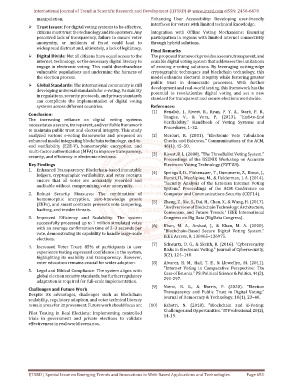Page 661 - Emerging Trends and Innovations in Web-Based Applications and Technologies
P. 661
International Journal of Trend in Scientific Research and Development (IJTSRD) @ www.ijtsrd.com eISSN: 2456-6470
manipulation. Enhancing User Accessibility: Developing user-friendly
interfaces for voters with limited technical knowledge.
Trust Issues: For digital voting systems to be effective,
citizens must trust the technology and its operators. Any Integration with Offline Voting Mechanisms: Ensuring
perceived lack of transparency, failure to ensure voter participation in regions with limited internet connectivity
anonymity, or incidents of fraud could lead to through hybrid solutions.
widespread distrust and, ultimately, a lack of legitimacy.
Final Remarks
Digital Divide: Not all citizens have equal access to the The proposed framework provides a secure, transparent, and
internet, technology, or the necessary digital literacy to scalable digital voting system that addresses the limitations
engage in electronic voting. This could disenfranchise of existing e-voting solutions. By leveraging cutting-edge
vulnerable populations and undermine the fairness of cryptographic techniques and blockchain technology, this
the election process. model enhances electoral integrity while fostering greater
public trust in democratic processes. With further
Global Standards: The international community is still development and real-world testing, this framework has the
developing universal standards for e-voting. Variability potential to revolutionize digital voting and set a new
in regulations, security protocols, and privacy standards standard for transparent and secure elections worldwide.
can complicate the implementation of digital voting
systems across different countries. References:
[1] Benaloh, J., Rivest, R., Ryan, P. Y. A., Stark, P. B.,
Conclusion:
Teague, V., & Vora, P. (2013). "End-to-End
The increasing reliance on digital voting systems
Verifiability." Handbook of Voting Systems and
necessitates a secure, transparent, and verifiable framework
Procedures, 1–32.
to maintain public trust and electoral integrity. This study
analyzed various e-voting frameworks and proposed an [2] Mercuri, R. (2001). "Electronic Vote Tabulation
enhanced model integrating blockchain technology, end-to- Checks and Balances." Communications of the ACM,
end verifiability (E2E-V), homomorphic encryption, and 46(1), 45–50.
multi-factor authentication (MFA) to improve transparency, [3] Rivest, R. L. (2008). "The ThreeBallot Voting System."
security, and efficiency in electronic elections.
Proceedings of the USENIX Workshop on Accurate
Key Findings Electronic Voting Technology (EVT'08).
1. Enhanced Transparency: Blockchain-based immutable [4]
ledgers, cryptographic verifiability, and voter receipts Springall, D., Finkenauer, T., Durumeric, Z., Kitcat, J.,
Hursti, H., MacAlpine, M., & Halderman, J. A. (2014).
ensure that all votes are accurately recorded and
"Security Analysis of the Estonian Internet Voting
auditable without compromising voter anonymity.
System." Proceedings of the ACM Conference on
2. Robust Security Measures: The combination of Computer and Communications Security (CCS'14).
homomorphic encryption, zero-knowledge proofs [5]
(ZKPs), and smart contracts prevents vote tampering, Zheng, Z., Xie, S., Dai, H., Chen, X., & Wang, H. (2017).
hacking, and insider threats. "An Overview of Blockchain Technology: Architecture,
Consensus, and Future Trends." IEEE International
3. Improved Efficiency and Scalability: The system Congress on Big Data (BigData Congress).
successfully processed up to 1 million simulated votes [6] Khan, M. A., Arshad, J., & Khan, M. A. (2020).
with an average confirmation time of 2–3 seconds per "Blockchain-Based Secure Digital Voting System."
vote, demonstrating its capability to handle large-scale IEEE Access, 8, 136965–136975.
elections.
[7] Schwartz, D. G., & Skeith, R. (2016). "Cybersecurity
4. Increased Voter Trust: 85% of participants in user
Risks in Electronic Voting." Journal of Cybersecurity,
experience testing expressed confidence in the system,
3(2), 124–140.
highlighting its usability and transparency. However,
voter education remains crucial for wider adoption. [8] Alvarez, R. M., Hall, T. E., & Llewellyn, M. (2011).
"Internet Voting in Comparative Perspective: The
5. Legal and Ethical Compliance: The system aligns with
Case of Estonia." PS: Political Science & Politics, 44(2),
global election security standards, but further regulatory
291-297.
adaptation is required for full-scale implementation.
[9] Niemi, R. G., & Norris, P. (2020). "Election
Challenges and Future Work Transparency and Public Trust in Digital Voting."
Despite its advantages, challenges such as blockchain Journal of Democracy & Technology, 10(1), 23–40.
scalability, regulatory adoption, and voter technical literacy
remain areas for improvement. Future work should focus on: [10] Kshetri, N. (2018). "Blockchain and E-Voting:
Challenges and Opportunities." IT Professional, 20(2),
Pilot Testing in Real Elections: Implementing controlled
14-19.
trials in government and private elections to validate
effectiveness in real-world scenarios.
IJTSRD | Special Issue on Emerging Trends and Innovations in Web-Based Applications and Technologies Page 651

